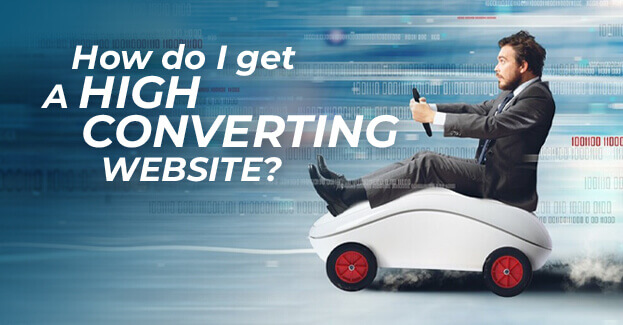One of the most frequently asked questions we get at XDesigns Advertising is how do I get a high converting website? We understand you may already have a website, most businesses these days do. It’s highly likely you’ve spent thousands of dollars for your website to look amazing, but is it converting visitors into paying customers? Are people navigating to your website and then bouncing from the homepage and leaving just as fast as they landed on your site? Perhaps your web traffic is constant, but you’re simply not getting the ecommerce sales you expected?
In a digitally saturated marketplace, there is so much more to website design than making your website look pretty! Sure, your web designer may amaze you with their techy know-how and aesthetics, but there’s more to a high converting website than simply looks.
What is website conversion?
When we talk about high converting websites, we mean the streamlining of the customer journey combined with easy navigation and clear instructions on where to go and what to do next. A website conversion occurs each time a visitor to your website lands on your homepage and successfully purchases a product, downloads a lead magnet such as an ebook, or fills in a contact form. Conversions are divided into two types: MIcro conversions and Macro conversions.
Micro conversions are when your customer takes a desired action such as watching video content or signing up for your newsletter. These are small steps that often take place before a visitor completes what we call a macro conversion—purchase a product, subscribe to your services or book a quote or appointment.
For your website to maintain high conversion rates there are several things that need to occur.
1. Speed
Your website needs to load fast! Loading times on both mobile and desktop computer should take between 2 to 5 seconds to load. You can check your download speed at https://developers.google.com/ to carry out a website diagnostics. It provides suggestions of how you can optimise your speed.
Things that can affect the speed of your website include:
- Huge files that haven’t been optimised
- Old technology such as Adobe Flash
- Coding issues
2. Wow your website visitors!
First impressions mean everything! Use high quality graphics (not to be confused with huge files) that highlight your products and services. If possible, use a professional photographer or videographer so your products and services are shown in their best light. Make sure your content is easy-to-understand and covers everything customers may want to know about what you’re offering.
An FAQ page when well-written will cover all the most frequently asked questions so that your customers can get the answers they are looking for without having to wait for you to reply. Not to mention it’s a great way to improve your SEO.
Provide social proof with case studies, testimonials and reviews. You could even use sales pop-ups which create a sense of urgency and FOMO by showing how many customers are currently viewing the same product.
3. You need to be easy to contact
Make it easy for customers to contact you! Include all your contact details on the homepage and footer of your website, as well as the contact page. Your website visitors don’t want to have to hunt for your details. By making it easy to find your contact information, you’re more likely to convert traffic to paying customers.
Many businesses include a clickable phone number in the top right hand corner of their website. It means those who are on mobile devices can simply click and call—no need to memorise those digits. Be sure to list your best email address and a contact form as well.
In addition to your website, having a social media presence on the main platforms also provides another avenue for customers to reach out. Be sure to respond to messages in a timely manner.
4. Provide value
By sharing insights, knowledge and solutions to your customer’s pain points, you are providing compelling evidence of what you can do for your website visitors and why they should choose your products or services. You can provide value through posting regular blogs or posting to social media. Get high engagement and lower the bounce rate on your website.
For example; if you are a hairdresser, you can provide value by writing blogs about how to care for your hair or what products can be used to treat different types of hair and scalp conditions. In addition to blog writing, you can provide value on your social media channels as well such as videos on how to do simple updos or reels on choosing hairstyles that suit different face types.
5. Retarget your visitors
Set up automated EDMs which can be sent to your customers when they abandon shopping carts or have viewed products that they didn’t end up purchasing. You can use a Facebook pixel on your website to retarget people that have visited your website but have yet to make a purchase. Make the customer journey so simplistic and easy to navigate that any website visitors will remember how simple the purchase process was, that they are more likely to return for repeat purchases.
6. Seek out reviews
Did you know that 98% of customers are more likely to make a purchase after reading reviews? You can include customer reviews on your individual products, a special testimonial page or link to Google reviews. It takes reading 6-10 recent reviews before most website visitors will make a purchasing decision (source: eKomi)
How do I get more reviews?
Many people are happy to provide reviews after a streamlined purchase process, the key is to ask or incentivise customers. For example; you may see signs in cafes or QR codes on tables saying ‘Leave us a review and get a free coffee’.
By using a review management platform it can help automate the process and then post the review directly to Google or via a widget to your website.
What happens when you contact XDesigns Advertising for a high converting website?
The process to your high converting website starts with the discovery phase. We familiarise ourselves with your company’s goals and then plan out the tasks that need to happen for this to be completed—such as: Will you need new photographs or your products and services? Do you need a downloadable ebook? Will there be video testimonials? How do you want people to contact you? What’s the end goal?
The next phase of the process is the development phase. Once we are familiar with your goals and what needs to be done to achieve this, we customise a web design and develop your website to streamline the customer journey. We not only think about it from the perspective as a customer, but how Google looks at your website and what needs to be done to get it to rank in search results.
Now one of the most exciting phases is the launch phase. Your website goes live. We monitor your website presence across all major internet browsers and tweak any areas that need to be fixed.
But wait, that’s not all. We make sure you are well-equipped to manage your website and maintain it for optimal functionality using DIY video instructions for those who want to look after it themselves, and maintenance packages for businesses who’d prefer to set and forget and let the team at XDesigns manage their website.
What next?
Now that you know all about high converting websites and you need a website audit, contact the team at XDesign Advertising. We will run a full check on your website and find out what’s working and what’s not. We’ll provide you with a full report and then the decision on where to from there is completely up to you.




